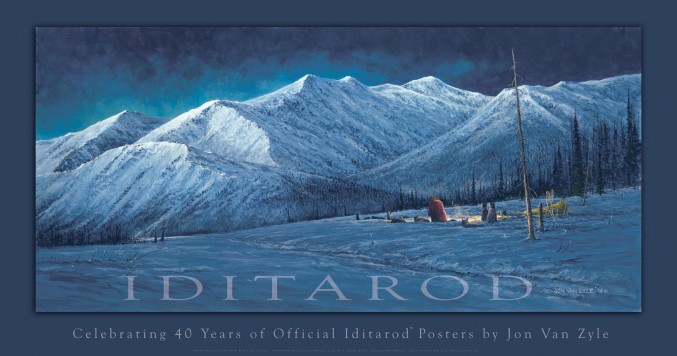Jon Van Zyle’s official poster for the 2016 Iditarod shows an immense snowy wilderness framed by mountains. A musher crouches over a small fire, which lights the surrounding dimness with a faint light. Nearby, shadowy figures of sled dogs at rest dot the snow. Off to the side, the trail leads our eye into the distance. We know that the team has just come from the trail, and will soon return to it, but not before this lonely moment of rest beside the long trail.

Jon Van Zyle’s artwork for the 2016 Iditarod Poster. Iditarod Media
Jon Van Zyle has been the official Iditarod artist since 1979. He has run the race twice. As the Iditarod gained traction in the 1970s, race organizers knew that having an official artist would do much to promote the ideals, tell the story, and communicate beyond words about the power and uniqueness of the Iditarod. In addition to promoting the Iditarod, Van Zyle’s art captures the wonder and mystique of Alaska for those who may not have experienced it.
I encourage you to visit Jon Van Zyle’s website to see the depth and breadth of his work. I especially like the Iditarod posters, whose purpose is to share a theme or message about the Iditarod. Some years, excitement and energy leaps off the canvas, while other years, the posters exhibit a more contemplative mood. My favorite is the 2021 “Angels Without Wings” poster, which honors sled dogs. I love it because I have such a great bond with my own dog. The dogs in this image are specific but also represent every beloved sled dog through the years.
In the same vein, NASA created its Artist’s Cooperation Program in 1962. It was the idea of James Webb, NASA’s second administrator, who served under Presidents Kennedy and Johnson. According to the Smithsonian National Air and Space Museum, it was hoped that the art program would share the cultural significance of human space exploration. Webb also wanted the images to convey deeper messages about the meaning of space exploration than one could get on the nightly news.
Among the artists given unrestricted access to all of NASA’s buildings were Norman Rockwell and Robert Rauschenberg, whom you may have heard of. However, I want to draw your attention to Lamar Dodd, one of the first artists chosen for the program. He was from Georgia and utilized a highly abstract style during his time at NASA during the Apollo 11 era. Yet he wanted all of his paintings for NASA to have a human perspective. Dodd’s painting “White Room” from 1963 depicts the space where astronauts first enter the spacecraft prior to launch. In this image, a lone attendant is almost swallowed by the technology surrounding him. Studying this image brings me greater understanding of the interplay between humans and the machinery of space exploration. Like the musher in Van Zyle’s painting, this figure is one with the surroundings.

“White Room” 1963, by Lamar Dodd, an artist of NASA’s Artists Cooperation Program. Collection of National Air and Space Museum.
Artists of the Iditarod and NASA alike create images that linger long in our minds—images that help us understand the subjects without words or flashy news stories. The NASA Art Program continues, as does the official connection between Iditarod and many artists. Both programs bring opportunities to students to share their art through contests, lessons and projects for the classroom. Find lessons and ideas in the Teach and Learn–The Arts section of the Iditarod Education website.
How do you and your students create art about the Iditarod? I’d love to hear from you. Email me at emailtheteacher@iditarod.com.


